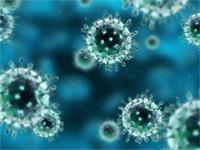APP-0205, APP-309 and other anti-influenza leads isolated from screening over 1,000 marine microorganism fractions in cytoprotection and cytotoxicity assays
Flu – A Serious, Deadly Disease with Pandemic Potential
 In 1918, the Spanish flu (H1N1 influenza virus) rapidly killed 50 to 100 million people worldwide, affecting one of every five Americans.
In 1918, the Spanish flu (H1N1 influenza virus) rapidly killed 50 to 100 million people worldwide, affecting one of every five Americans.
Today, influenza remains a common and serious respiratory illness that contributes to the reduction of quality of life and results in a significant loss of manpower hours each year. Every year, 40 million Americans catch the flu and 20,000 to 40,000 Americans die from it, making it the deadliest infectious disease in the United States.
In the case of a pandemic caused by a mutated H5N1 virus or other flu strain, the mortality rate will increase by several orders of magnitude. Tamiflu® is the leading antiviral effective against H5N1, but there have been instances where the H5N1 virus and mutant strains have become resistant to Tamiflu®. Thus, there is a need for additional effective anti-influenza therapeutics.
Looking To Nature for Anti-Influenza Drugs
Nature is an excellent source of novel anti-influenza drugs. In fact, 71% of the antiviral New Chemical Entities (NCEs) approved over the 20-year period, 1981-2001, including Tamiflu®, are naturally derived from or based on a natural product.
Oceans Can Provide Solutions
Oceans are an enormous source of chemical and genetic biodiversity, and potentially resource-rich for the discovery of novel anti-influenza drugs.
Aphios’ scientists and engineers are screening a unique library of diverse marine microorganisms – isolated from normal to extremophilic environments in United States territorial waters – and medicinal plants to discover novel anti-influenza drugs. Research is being done under Biohazard Safety Level-3 (BSL-3) conditions.
The Company utilizes its patented SuperFluids™ CXF fractionation technology for the rapid discovery and development of anti-influenza drugs.
Fractionation for Effective Screening 
CXF fractionation technology is utilized to effectively disrupt marine microorganisms and selectively extract bioactive compounds based on their polarities. In comparative screening programs with Bristol-Myers Squibb and Pfizer, CXF technology was shown to:
- Produce a unique spectrum of secondary metabolites
- Reduce interference from nuisance compounds
- Minimize background noise in sensitive molecular assays
- Enhance the probability of “clean” hits
A closely related CXP technology platform can be utilized to manufacture drugs for preclinical development and commercial production.
Research to Date – Anti-Influenza Leads
 To date, utilizing proprietary enabling drug discovery technologies, we have screened about 1,000 marine molecule fractions (approximately 2% of our marine microorganism library) against influenza A (H3N2) and influenza B in biological assays. Hits were selected on the basis of a Selectivity Index (SI) that reflects therapeutic efficacy.
To date, utilizing proprietary enabling drug discovery technologies, we have screened about 1,000 marine molecule fractions (approximately 2% of our marine microorganism library) against influenza A (H3N2) and influenza B in biological assays. Hits were selected on the basis of a Selectivity Index (SI) that reflects therapeutic efficacy.
We have identified 2 very active hits (SI >100) against influenza B, 13 active hits (SI >10) against influenza A and 21 moderately active hits (SI > 1) against influenza A. From screening medicinal plants utilizing proprietary drug discovery technologies, we have identified an anti-influenza hit that has a selective index against influenza A that is higher than the positive control utilized in the biological assays.
Our Anti-Influenza [Amyxa®] Goal
Our overall goal is to establish a business unit Amyxa® Therapeutics with a mission to identify compounds from marine microorganisms and medicinal plants that are active against different strains of influenza A, including H5N1 viruses and influenza B, as well as those that act on viral proteins other than ones targeted by current anti-influenza drugs.
We have ongoing research agreements with the National Institute of Allergy and Infectious Diseases, NIH and United States Army Medical Research Institute of Infectious Diseases, DOD for testing compounds against different strains of influenza.